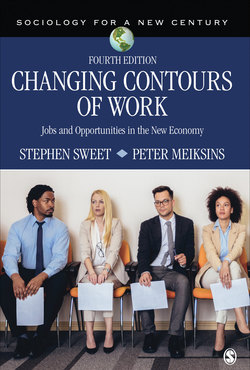Читать книгу Changing Contours of Work - Stephen Sweet - Страница 9
На сайте Литреса книга снята с продажи.
Chapter 1 Mapping the Contours of Work
ОглавлениеPerhaps more than any other quality, the ability to plan, organize, and collectively engage in work sets human beings apart from other species. Work occupies most of our waking hours; it is a crucial part of identities and influences life chances. At the same time, work creates problems in lives and, at its worst, it can become a sentence of grinding toil in jobs that offer few rewards. Our understanding that work can liberate but also enslave—and seeing both possibilities exemplified in the modern economy—inspired us to write this book. We wanted to take stock of work today—to consider the types of work opportunities available, chart how jobs emerge and disappear, and gauge the impact of workplace practices on and off the job. Beyond this, we wanted to reflect on how work could be organized so that it makes sense—so that it provides the resources people need and brings meaning to lives.
This chapter begins this discussion by considering the “contours of work.” These contours can be thought of as the terrain on which work opportunities are distributed and traversed. The metaphor of contours is useful because, like geographic topographies, work opportunities have been etched into the landscape by long-term historical forces. Some of these forces resulted in profound changes, wherein old ways of working were abandoned and new methods introduced. This type of radical transformation occurred in the Industrial Revolution of the early nineteenth century, and some argue that computer and communication technologies are having a similar effect today. Other forces, however, shape opportunity landscapes in more gradual, ongoing, and cumulative processes. Social divisions created on the basis of gender, with its constantly evolving meanings and practices, are one such force. So are race and social class divisions.
To consider the impact of social forces on work, we introduce here a shorthand distinction that we use throughout this book: the division between the old and new economies. This dichotomy helps us identify the very real changes that occurred in work in the latter part of the twentieth century, including the introduction of computer technologies, the expansion of a global economy, shifts in the composition of the workforce, new organizational and managerial paradigms, and other transformations that we consider in the chapters to come. The old economy represents the various ways of assigning and structuring work that developed in the wake of the Industrial Revolution through the mid-twentieth century. This economy operated with systems oriented to mass production, gendered divisions of labor, unionized labor, and a variety of other enduring workplace practices. It was also an economy in which the United States was a central and dominating economic force. The concept of a new economy is used to examine the question of whether the nature of work has changed and, if it has, the extent to which these changes are affecting lives on and off the job. Our primary frame of reference throughout this book is work as it occurs in the United States but also as it is connected to the distribution of opportunities in the global economy.
Though we use the term new economy, we have come to conclude that many of the present-day contours reflect the way work evolved in the old economy.1 Those arguing that there has been a “second industrial revolution” often ignore this. There are new jobs, new workers, and new work designs, and these are changing some of the ways work is performed, by whom, and the returns received. But many of the features introduced by the old economy remain. These “old” features are not simply vestiges destined to eventually die out; they are thriving and may be permanent features of the new economy that will continue to develop during the twenty-first century. Sometimes these old and new features are combined, for example, when low-skill factory work jobs are moved from the developed world to the emerging economies. The jobs may not have changed fundamentally, but the people who are performing them have. In Chapter 2, we consider the issue of production in the old and new economies in greater detail and assess the extent to which work in the new economy has changed and the extent to which it has remained the same.
Our discussion in this chapter is directed to identifying the dominant social forces that shape work opportunity. We organize this discussion by considering three interlocking concerns:
Culture: meaning systems that attach individuals to work, harness their commitments, and direct their efforts.
Structure: opportunities, as well as constraints, that shape what types of jobs can be pursued, by whom, and the returns received.
Agency: personal effort and discretion, whether as individuals or in groups, to direct actions and decisions.
To open this discussion, we consider the lives of six workers laboring in the new economy and the rewards, strains, and constraints work produces in their lives. As you read these examples of what work is like in the new economy, reflect on the ways current opportunity structures allocate resources needed and think about how work provides meaning but also disrupts lives. The challenge we explore throughout this book is finding ways to align culture, structure, and human initiative in pursuit of expanding, work opportunity. In other words, the goal is to reduce the incompatibilities between how jobs are arranged and what workers can bring to—and receive from—their work.
